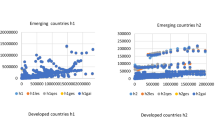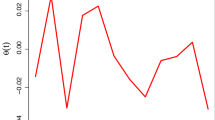Summary
This paper gives an empirical reexamination of the “Linear-Expenditure”-hypothesis for Austria. It starts with a brief theoretical discussion of the principal properties and restrictions of the “Linear-Expenditure-System” (LES). To obtain empirical estimates of the parameters of the LES two different estimation procedures are applied, i.e. the original method used byStone and a simplified version of the “Systems-Least-Squares”-approach (following theMarquardt-algorithm). There are no essential differences between these estimates. They all seem plausible and satisfy the theoretical restrictions.
Usually the stability (i.e. time-invariance) of the parameters is accepted without proof. Using the “Moving-Window-Regression”-technique, however, most of the estimates vary significantly in time. To obtain a direct proof of the time-dependence of the parameters the LES is reestimated now including trend-factors. Especially results considering time-dependent marginal-budget-shares are considerably better than the static-model results.
The conclusion of this paper is that the static version of the LES does not explain the consumer behaviour in Austria and that much more effort should be spent on the estimation of dynamic demand systems.
Similar content being viewed by others
Literaturverzeichnis
W.H. Branson-A.K. Klevorick: Money Illusion and the Aggregate Consumption Function. In: American Economic Review, Vol. 59, 1969, S. 832–849.
F. Carlevaro-E. Rossier: Le Programme LINEX pour l'Estimation des Paramètres du Système Linéaire de Dépenses. Centre d'Economètrie, Faculté des sciences économiques et sociales, Université de Genève, Cahier 15/6/70, Genf 1970.
F. Carlevaro-E. Sadoulet: Trois Programmes, d'estimation d'une Classe Générale de Fonctions de Consommation Additives, Centre d'economètrie, Faculté des sciences économiques et sociales, Université de Genève, Cahier 1973/1, Genf 1973.
E. Fidler: Empirische Schätzung eines ökonometrischen Konsummodells für Österreich, Wien (Dissertation) 1971.
R. Frisch: A Complete Scheme for Computing all Direct and Cross Demand Elasticities in a Model With Many Sectors. In: Econometrica, Vol. 27, 1959, S. 177–196
R.C. Geary: A Note on “A Constant-Utility Index of the Cost of Living”. In: Review of Economic Studies, Vol. 18, 1950/51, S. 65–66.
A.S. Goldberger: Functional Form and Utility: A Review of Consumer Demand Theory, University of Wisconsin, Social Systems Research Institute (Systems Formulation, Methodology, and Policy Workshop Paper 6703), 1967.
H.A.J. Green: Consumer Theory, Harmondsworth 1971 (Penguin Modern Economic Texts).
J.R. Hicks-R.G.D. Allen: A Reconsideration of the Theory of Value (Part I and II). In: Economica, N.S. Vol. 1, 1934, S. 52–76 und S. 196–219.
J. Johnston: Econometric Methods, 2nd ed., Tokio etc. 1972 (International Student Edition).
L.R. Klein-H. Rubin: A Constant Utility Index of the Cost of Living. In: Review of Economic Studies, Vol. 15, 1947/48, S. 84–87.
G. Kohlhauser: Der private Konsum in Österreich: Eine Zeitreihenanalyse. In: Monatsberichte des Österreichischen Institutes für Wirtschaftsforschung, Heft 5/1973, S. 241–263.
G. Kohlhauser: Wandlungen und Prognose der österreichischen Konsumstruktur. In: Monatsberichte des Österreichischen Institutes für Wirtschaftsforschung, Heft 1/1975, S. 8–25.
E. Malinvaud: Statistical Methods of Econometrics, Amsterdam 1968.
D.W. Marquardt: An Algorithm for Least Squares Estimation of Non-linear Parameters. In: Journal of the Society of Industrial and Applied Mathematics, Vol. 11, 1963, S. 431–441.
R.W. Parks: Maximum Likelihood Estimation of the Linear Expenditure System. In: Journal of the American Statistical Association, Vol. 66, 1971, S. 900–903.
L. Phlips: A Dynamic Version of the Linear Expenditure System. In: Review of Economics and Statistics, Vol. 54, 1972, S. 450–458.
L. Phlips: Applied Consumption Analysis, Amsterdam 1974.
R.A. Pollak: Habit Formation and Dynamic Demand Functions. In: Journal of Political Economy, Vol. 78, 1970, S. 745–763.
R.A. Pollak-T.J. Wales: Estimation of the Linear Expenditure System. In: Econometrica, Vol. 37, 1969, S. 611–628.
A.A. Powell: Empirical Analytics of Demand Systems, London 1974.
P.A. Samuelson: Some Implications of Linearity. In: Review of Economic Studies, Vol. 15, 1947/48, S. 88–90.
K. Sato: Additive Utility Functions with Double-Log Consumer Demand Functions. In: Journal of Political Economy, Vol. 80, 1972, S. 102–124.
P. Schönfeld: Methoden der Ökonometrie, Band 1, München 1969.
L. Solari: Théorie des Choix et Fonctions de Consommation Semi-Agrégées, Genf-Paris 1971.
R. Stone: Linear Expenditure Systems and Demand Analysis: An Application to the Pattern of British Demand. In: Economic Journal, Vol. 64, 1954, S. 511–527.
A. Zellner: An Efficient Method of Estimating Seemingly Unrelated Regressions and Tests for Aggregation Bias. In: Journal of the American Statistical Association, Vol. 57, 1962, S. 348–368.
Rights and permissions
About this article
Cite this article
Bekerle, F. Nachfragesysteme für österreich. Empirica 5, 3–31 (1978). https://doi.org/10.1007/BF00925218
Issue Date:
DOI: https://doi.org/10.1007/BF00925218




